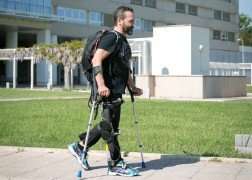An exoskeleton for paraplegics

Robotic devices are increasingly being used to assist patients with impaired motor functions. Through a novel adaptable exoskeleton, the Symbitron project hopes to revolutionise rehabilitation of patients.
Spinal cord injury (SCI) can lead to paraplegia, the loss of movement in the lower part of the body. Recent research efforts to treat SCI and restore partial movement have resulted in the development of assistive exoskeletons. Considering that active recruitment of the neuromuscular system in SCI patients could promote motor recovery, exoskeletons must be responsive to both the user and the environment.
The EU-funded Symbitron project was a four-year initiative that aimed to develop a safe, bio-inspired, personalised wearable exoskeleton. "Our main aim was to enable SCI patients to walk without additional assistance, by complementing their remaining motor function,″ explains project coordinator Prof. Herman van der Kooij.
A patient-centred design
The Symbitron exoskeleton was based on a fully customised solution that complements the unique remaining capacities of each individual patient. The design was unique as it replicated physiological neuromuscular functionality while seamlessly integrating residual human functionality.
Researchers employed dynamic models of lower limb muscles to assist the gait of SCI subjects by recreating human behaviour via joint kinematics, kinetic measures, and muscle activations. The models were based on clinical data measured from healthy subjects and SCI patients. The generated exoskeleton controller required very few inputs from joint angles, stance, and swing detection to simulate walking at different speeds and terrains. It also demonstrated robustness against perturbations and environmental disturbances.
Alongside extensive optimisation of the design and control, considerable emphasis was given on the bi-directional symbiotic man-machine interaction of the wearable exoskeletons. The modular exoskeleton can be modified to the size and capacities of different subjects using different configurations, namely only ankle support, ankle-knee support, or ankle-knee-hip support. It is also possible to support only one or both legs. Furthermore, the electronic and mechanical modularity is automatically recognised by the respective software to adapt performance to the specific needs of the user.
Clinical impact
To provide clinical proof of concept for safety and functionality of the system, the Symbitron consortium developed a training environment and training protocols for SCI patients and their clinicians. The project employed incomplete SCI subjects that needed only support at the ankle or at the ankle and knee, and complete SCI subjects that needed full support of both legs.
"Clinical tests showed that hardware and software could be adjusted to the specific characteristics of these subjects providing a proof of the feasibility of our unique approach,″ emphasises Prof. van der Kooij. Importantly, the biologically inspired controllers – in contrast to conventional approaches – allowed for variable gait patterns in term of speed and step length.
The results were very promising, with all incomplete SCI subjects improving their walking speed and/or balance during training and two complete SCI subjects walking again. In some cases, a rehabilitation effect was seen after training with the Symbitron devices even when the subjects did not use the device. Psychometric analysis also validated patient satisfaction and motivation for further improvement.
Prof. van der Kooij is hopeful that "although clinical results are still preliminary, training with the Symbitron devices seems to improve walking of subjects who have some remaining function left.″ This suggests that the support offered by the Symbitron approach could extend beyond SCI subjects, such as for the rehabilitation of stroke survivors.
More information: www.symbitron.eu/
Provided by CORDIS





















